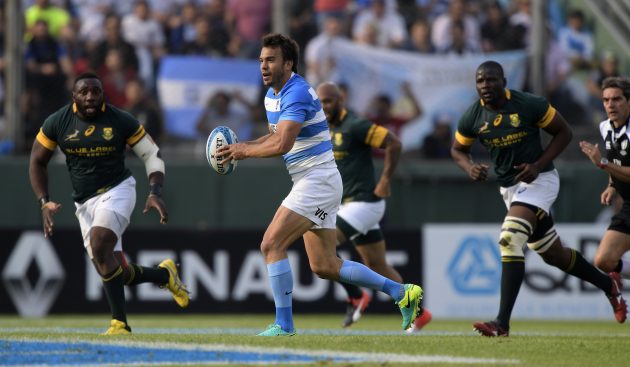While many in the Northern Hemisphere commented on the demise of the Springboks, fewer looked at the reasons for Argentina's continued resurgence...
Times, they may be a changing. The traditional triumvirate of power in the Southern Hemisphere – New Zealand, Australia and South Africa – is no longer the all-powerful force it once was. New Zealand are still way out in front, but the signs are that both the Springboks and Wallabies may be in perilous decline.
In recent times, both countries have bought into the folly of Super rugby expansion. Australia added a fourth team to their original three in 2006 (Western Force) and increased that to five in 2011 with the establishment of the Melbourne Rebels. The situation in South Africa is similar, with the Cheetahs and now the Kings added to the Super rugby roster.
At the same time, the outflow of home-grown provincial and Test-quality players to European clubs has quickened, especially since the 2011 World Cup. Local problems beset the ARU and SARU, with Australia under constant pressure from Aussie Rules and Rugby League to keep its share of the sporting market, and the political scenario in South Africa dictating the need for ‘quotas’. 50% of players selected to the Springboks must be coloured by the time of 2019 World Cup, with 60% of those to be black African.
The leakage of established players to Europe and Japan, and the dilution of the talent remaining have weakened Australian and South African rugby to the point where the door is ajar for someone else to stake their claim on the international scene.
England has already jammed its foot in that door with Eddie Jones winning his first nine Tests in charge and sweeping the Wallabies in the June series, away from home.
The other country which may fill the power vacuum, and become a regular top three rugby nation, is Argentina. The Pumas reached the semi-finals of the 2015 World Cup after despatching Ireland in one of the games of the tournament, and they have started the Rugby Championship by sharing the home-and away series against South Africa one match apiece, with last Saturday’s highlights on Sky Sports (below). If it had been a boxing contest over the two matches, the Pumas would have won it on points convincingly.
The Pumas have also been playing with one hand tied behind their backs. Several potential starters have been stripped away from the selection process because of the increasingly fraught issue of player release, especially from clubs in France and England.
Players like Marcos Ayerza and Juan Figallo at prop, Mariano Galarza, Juan Fernandez Lobbe and Leonardo Senatore in the back five forwards, and Juan Imhoff and Marcelo Bosch in the backs would all have been likely first choices had they been available.
Despite their losses, Argentina has forged ahead in the development of a winning Test side.
The most impressive aspect of their play is the desire to attack from within their own last third of the field – from the goal-line out to just beyond their own 22m zone.
In the second match against the Springboks in Salta, the Pumas ran the ball out of their own 22 metre area no less than seven times. They scored two tries (or near-tries), engineered two other clean breaks and finally won the penalty that secured the win in the closing minutes with another piece of counter-attacking ambition from deep.
Argentina created two of its best opportunities in the first half within five minutes of each other. The first came from a kick received by Juan Manuel Leguizamon on the left side of his own 22.
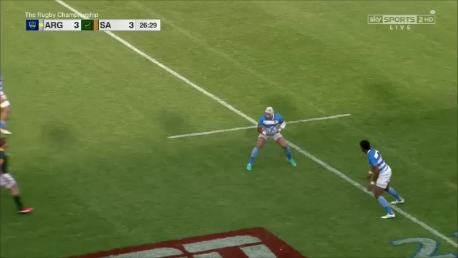
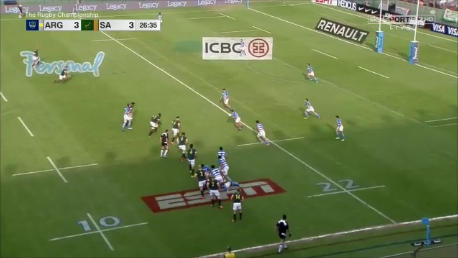

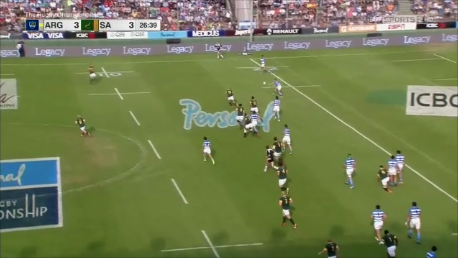
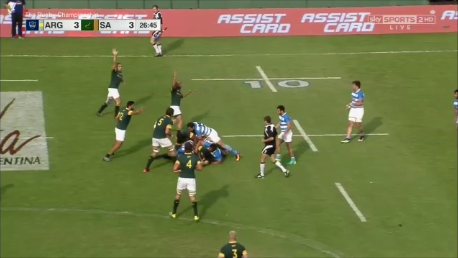
These five images illustrate the basis of Argentina’s play.
- Why take the risk of attacking from your own 22 and making a fatal handling mistake? There are only ten Springbok defenders in the line. An eleventh is buried in the ruck at 26:35, while numbers 9, 10, 11 and 15 are out of shot in the backfield. The risk is fully balanced by the potential reward.
- What do you need to create the attacking momentum? Argentina’s ‘T-bone’ attacking shape has an excellent ball-handling forward (Agustin Creevy) at its tip, and an ambitious, communicative backs receiver behind him in Nicolas Sanchez at 26:35. At 26:36 Creevy sucks in all the Springbok forward defenders before releasing the pass to Sanchez in behind. This leaves the Pumas with a temporary three-on-two against the two isolated South African centres.
- Why the second play-maker? The Argentines still need a good second distributor to get the ball to the wide channels on favourable terms. That playmaker is #12 Juan Martin Fernandez, who throws an excellent long pass off his left hand out in front of Santiago Cordero at 26:39. The first part of the sequence concludes with a positive ruck out beyond the Argentine 40m line at 26:45.
The second half of the sequence demonstrates how quickly the Pumas are capable of swinging the ball wide-to-wide, and bringing play back to the original side-line in only four phases.
After one more forward drive, the Pumas are prepared to shift the ball wide once more:
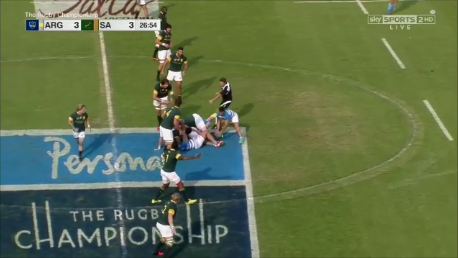
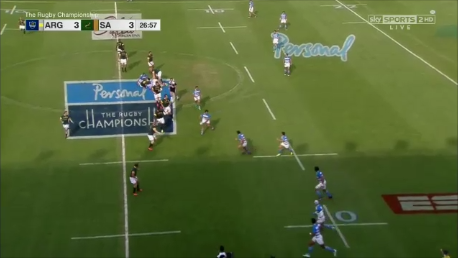


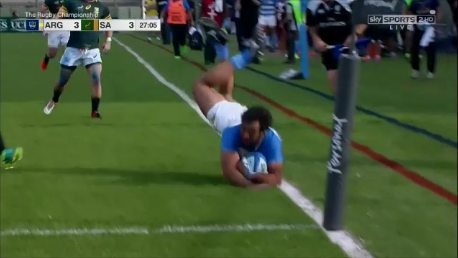
After the second pass is made at 26:57, there are no less than five Argentine attackers flooding the wide attacking area from the 15m line out towards touch. Another key ball-handling forward, #5 Tomas Lavanini, runs an excellent straightening line before hooking a one-handed offload around the back of the defender at 27:01 to release the wing outside him.
At 27:02 the Argentine attacking ‘risk’ has clearly achieved its reward. The player in possession, No 13 Matias Orlando has broken free and the two players closest to him are also wearing sky-blue shirts, which means Argentina has won the support battle and achieved a greater concentration of manpower in the decisive area of the field. It takes a terrific push-out tackle by Eben Etzebeth to stop Orlando just short of the South African goal-line.
The second sequence shares many of the same themes. On this occasion, No 6 Pablo Matera takes the ball up instead of passing into the second line of attack. His half-break leaves the South African scrum-half Faf de Klerk on the ground and on the wrong side of the breakdown, which in turn allows Hernandez to chip into the zone de Klerk would have been defending on the following phase:
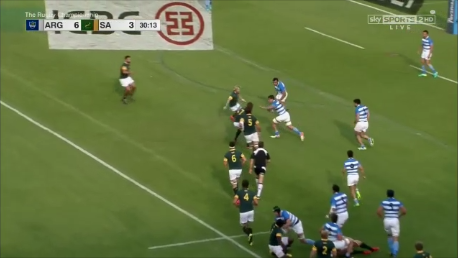

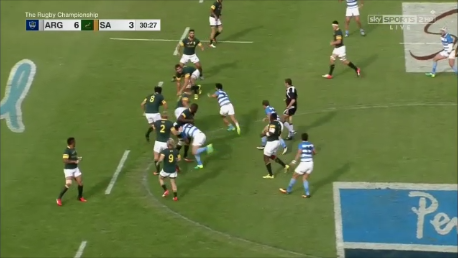
Martin Landajo regathers the ball for the Pumas and the scene is set for another five-man flood wide down the left hand side.
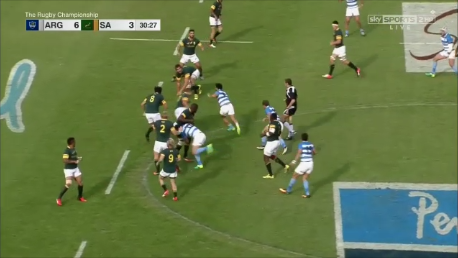
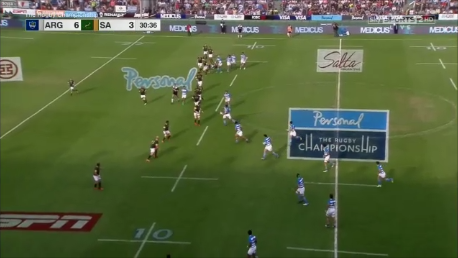
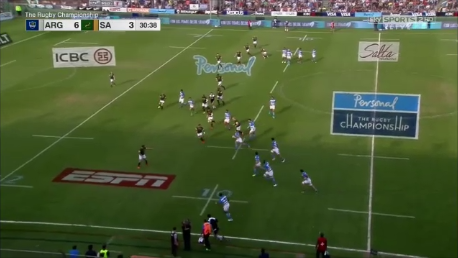
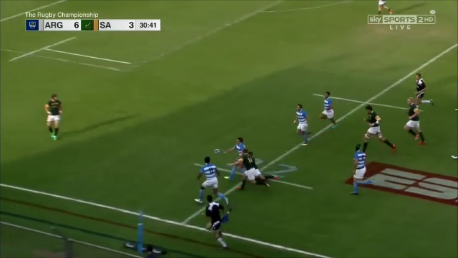

Once again Lavanini has a key role as a passer at 30:36, once again Argentina pack the near-side 15m corridor with five attackers at 30:38, and once again there are offloads in contact with the Pumas winning the battle of inside support and concentration in the key area of attack (30:41 & 30:42). This time there is no stopping full-back Joaquin Tuculet en route to the try-line.
The virtues of Argentina’s attacking philosophy were constantly reinforced throughout the rest of the game. They scored a second try from a crosskick, with forwards (Creevy and Lguizamon) maintaining their width on the opposite side of the field…
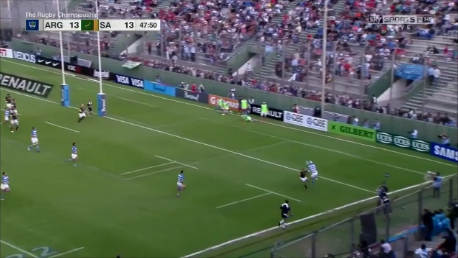
…while it was the decision by replacement outside-half (No 22 Santiago Gonzalez Iglesias) to take a quick restart from his own 22 which set up the position for the Pumas’ game-winning penalty:
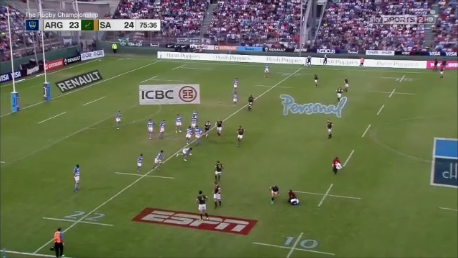
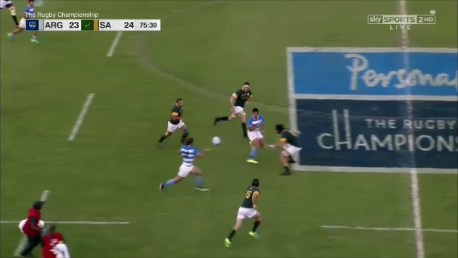
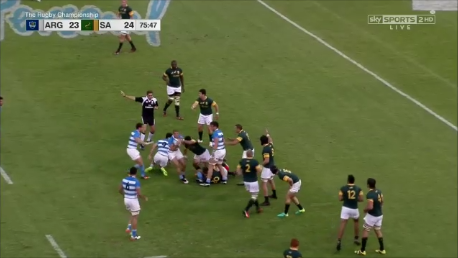
If Argentina can maintain their momentum in the remainder of the Rugby Championship, and the positive energy they derive from the ambition and exuberance of their long-range attacks, they will not only be a handful for any opponent (including the All Blacks), they will have a good shot at becoming established as the number three ranked rugby nation in the world for a long time to come.
Watch the Rugby Championship Live on Sky Sports. For more details of visit: www.sky.com/SkySports





